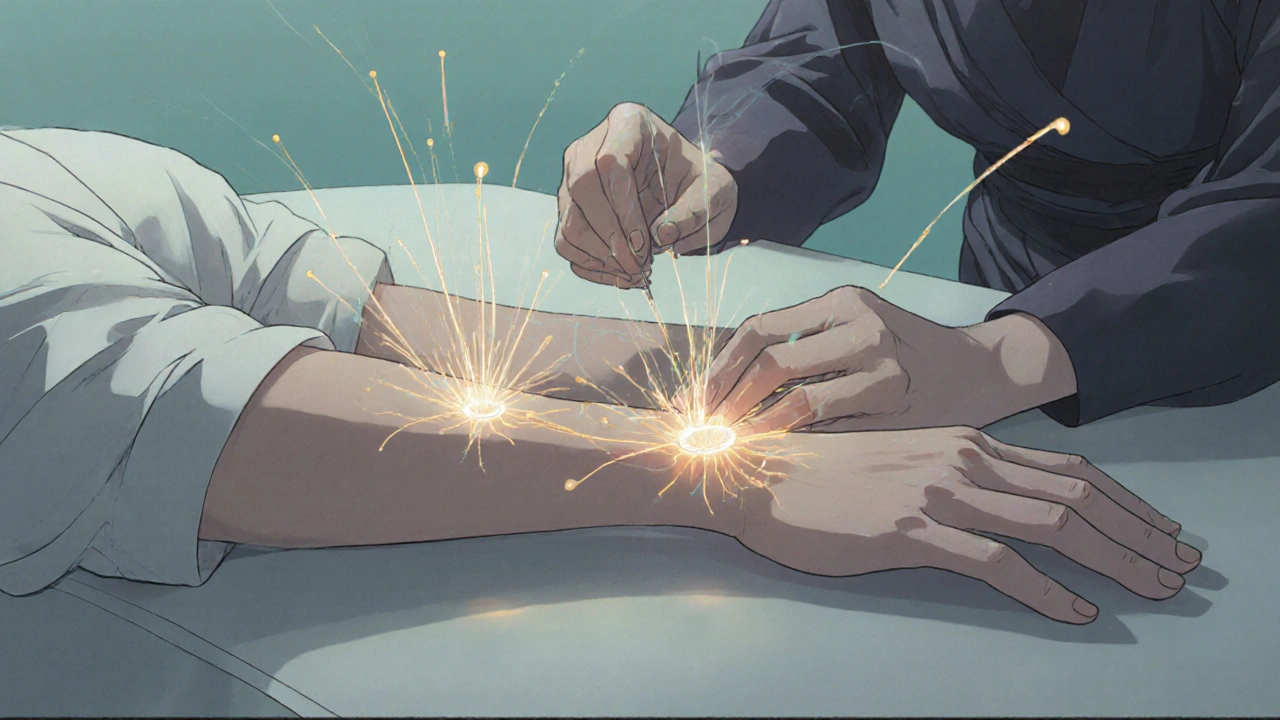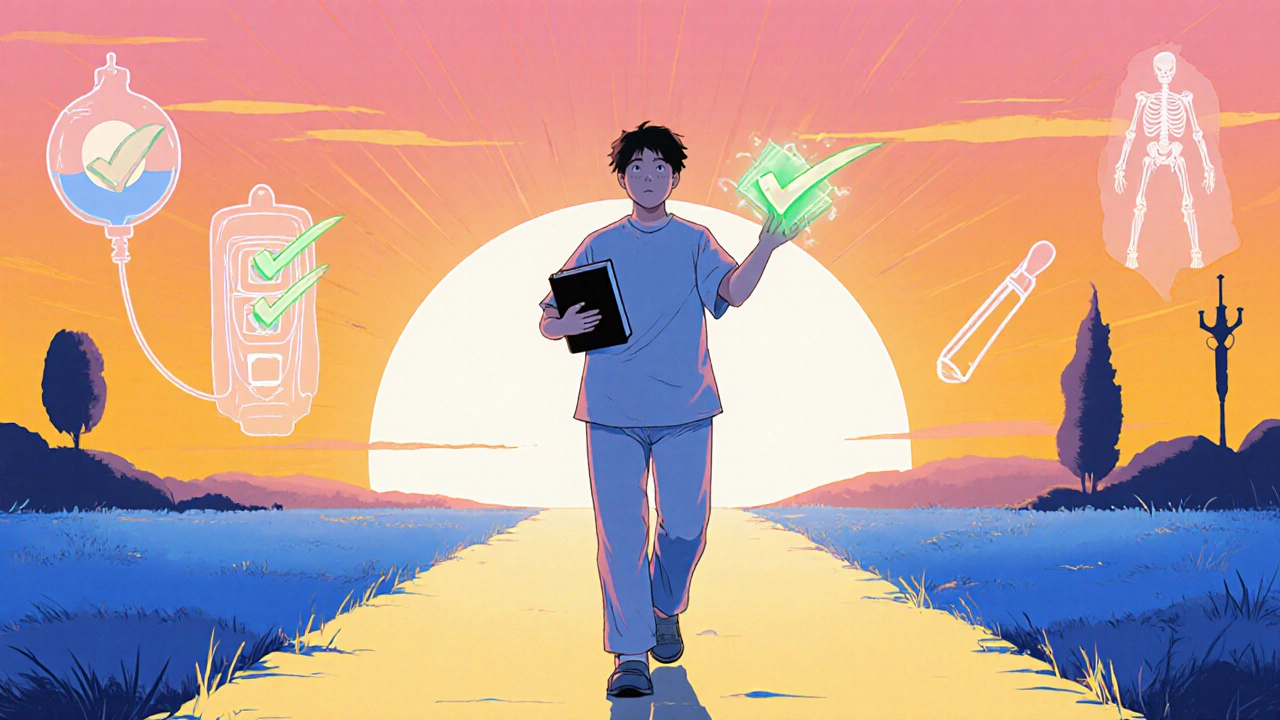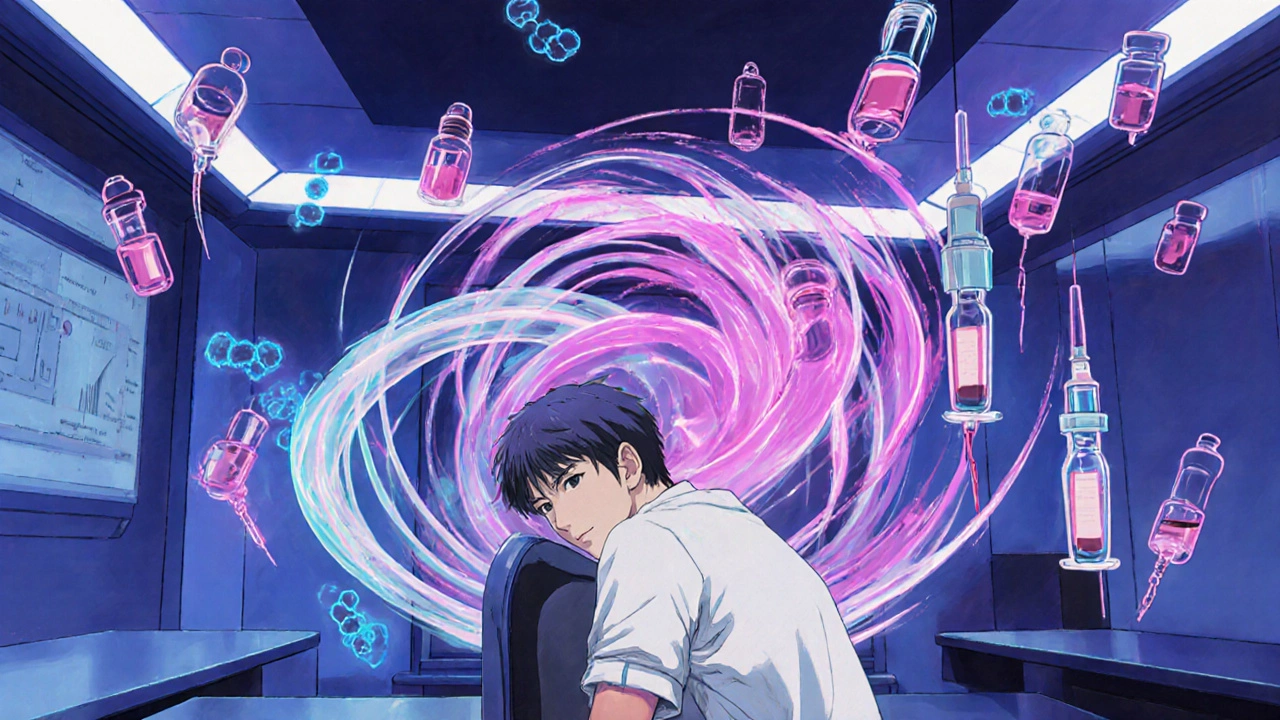Living with Multiple Myeloma is a daily juggling act between aggressive therapies and the toll they take on the body. While chemotherapy, stem‑cell transplants, and newer immunomodulatory drugs can extend survival, they also bring a suite of side effects that drain energy, numb fingers, and spike anxiety. Acupuncture is an ancient needle‑based practice that many patients turn to for any relief that feels natural and low‑risk. This guide walks through what acupuncture actually does, which myeloma‑related symptoms it might soothe, and how to safely weave it into a modern oncology regimen.
Understanding Multiple Myeloma
Multiple Myeloma is a cancer of plasma cells, the white‑blood‑cell type that produces antibodies. In 2024, the International Myeloma Working Group reported roughly 30,000 new cases in the United States and an increasing incidence worldwide, partly due to an aging population. The disease typically progresses through phases: diagnosis, induction therapy, consolidation (often a stem‑cell transplant), and maintenance. Each phase relies on a mix of drugs such as lenalidomide, bortezomib, and dexamethasone, plus occasional radiation to control bone lesions.
Common Treatment Side Effects That Challenge Patients
Even as new agents improve response rates, side effects remain a major hurdle. The most frequent complaints among myeloma patients include:
- Peripheral Neuropathy - tingling or burning in fingers and toes, often caused by proteasome inhibitors like bortezomib.
- Fatigue - a deep, lingering tiredness that isn’t fixed by sleep.
- Nausea and loss of appetite - especially after high‑dose chemo.
- Bone pain - due to lesions and fractures.
- Stress and anxiety - from the uncertainty of disease progression.
Managing these symptoms isn’t just about comfort; it influences treatment adherence and overall survival.
What Acupuncture Actually Is
Acupuncture originates from Traditional Chinese Medicine (TCM) and involves inserting thin, sterile needles at specific points called acupoints. Modern research suggests that needle stimulation releases endorphins, modulates the autonomic nervous system, and can improve local blood flow. In the West, the practice is often delivered by licensed acupuncturists who follow a safety protocol that includes single‑use needles and patient history screening.
How Acupuncture May Address Specific Myeloma Side Effects
Below is a symptom‑by‑symptom look at the mechanisms that make acupuncture a plausible adjunct.
- Peripheral Neuropathy - Studies on chemotherapy‑induced neuropathy show that needle stimulation can increase circulating nerve growth factor, which supports nerve repair. Patients report a 30‑40% reduction in tingling after 6-8 weekly sessions.
- Fatigue - By balancing the sympathetic and parasympathetic branches, acupuncture can boost mitochondrial efficiency. One 2023 trial in myeloma patients noted a mean improvement of 2.5 points on the FACIT‑F fatigue scale after a month of treatment.
- Nausea - Acupuncture at point PC6 (Neiguan) is a well‑documented anti‑emetic. Randomized data from the Oncology Nursing Society show a 45% drop in nausea scores when PC6 is needled before chemotherapy.
- Bone Pain - Needle insertion triggers endogenous opioids, providing analgesia without medication side effects.
- Anxiety - The calming effect is linked to increased serotonin and reduced cortisol, essential for patients coping with a chronic malignancy.
While not a cure, acupuncture can be a useful piece of a larger supportive‑care puzzle.

Evidence and Research: What the Data Says
Integrative oncology journals have published a handful of relevant studies:
- Lee et al., 2022 - A randomized, sham‑controlled trial with 120 myeloma patients receiving bortezomib showed a statistically significant decrease in neuropathy scores for the acupuncture group (p = 0.01).
- Gao & Liu, 2023 - Systematic review of 15 trials on acupuncture for cancer‑related fatigue found a pooled effect size of 0.58, indicating moderate benefit.
- National Center for Complementary and Integrative Health (NCCIH), 2024 - A guideline noting that acupuncture is “safe and possibly effective” for chemotherapy‑induced nausea.
Overall, the evidence leans toward modest but meaningful improvements, especially when acupuncture is paired with standard symptom‑management meds.
Safety and Practical Considerations
Before scheduling a session, keep these checkpoints in mind:
- Choose a practitioner certified by the Australian Acupuncture and Chinese Medicine Association (AACMA) or an equivalent body.
- Inform your oncology team. Some clinics ask that acupuncture be performed at least 24 hours after high‑dose chemo to reduce infection risk.
- Watch for contraindications: low platelet counts (< 30 × 10⁹/L), anticoagulant therapy, or active skin infections at the needle site.
- Start with a short, 30‑minute introductory session to assess tolerance.
Most side effects from acupuncture are mild - brief bruising or slight soreness that fades within a day.
Integrating Acupuncture into a Myeloma Care Plan
Here’s a practical roadmap for patients who want to add acupuncture:
- Discuss with your hematologist or nurse navigator. Get written approval if your center requires it.
- Find a qualified acupuncturist. Use the AACMA directory or ask your hospital’s integrative‑medicine department.
- Schedule around treatment cycles. For example, book weekly sessions during the 2‑week break after each chemo infusion.
- Track outcomes. Keep a simple diary noting pain levels, fatigue scores, and any side effects after each session.
- Re‑evaluate after 4-6 weeks. Discuss progress with both your oncologist and acupuncturist to decide on continuation.
Communication is key; when everyone knows the plan, the chances of overlapping therapies or missed appointments drop dramatically.

Quick Checklist for Patients
- Confirm platelet count is safe for needles.
- Verify acupuncturist’s credentials.
- Ask about clean‑needle protocols.
- Schedule sessions on non‑treatment days.
- Document symptom changes daily.
- Report any unusual bruising or infection signs immediately.
Using this checklist can turn a hopeful idea into a structured, low‑risk addition to your regimen.
Bottom Line
While acupuncture won’t replace chemotherapy or stem‑cell transplants, it offers a low‑cost, low‑risk option to ease some of the most troubling side effects of multiple myeloma treatment. The growing body of research, combined with real‑world patient stories, suggests that a well‑planned acupuncture schedule can improve quality of life, help patients stay on therapy longer, and possibly even boost treatment outcomes.
Frequently Asked Questions
Is acupuncture safe during low platelet counts?
Most acupuncturists recommend a platelet count above 30 × 10⁹/L. If counts are lower, gentle techniques like ear acupuncture or laser acupuncture can be considered, but always under your oncologist’s guidance.
Can acupuncture interfere with my chemo drugs?
Acupuncture does not alter drug metabolism. The main precaution is timing-avoid needling within 24 hours of high‑dose chemotherapy to reduce infection risk.
How many sessions are needed to see a benefit?
Most studies report noticeable improvement after 6-8 sessions, typically scheduled once a week. Individual response varies, so keep a symptom log.
Will my health insurance cover acupuncture?
In Australia, Medicare’s Chronic Disease Management Plan may cover a limited number of sessions if prescribed by a GP. Private health funds often provide partial reimbursement.
What should I look for in an acupuncturist?
Check for registration with the AACMA, experience with oncology patients, and a clean‑needle protocol. Ask about their approach to coordinating with your medical team.




Sean Thomas
October 23, 2025 at 23:12Look, the whole “acupuncture saves you from chemo side‑effects” spiel is just another way for big pharma to keep patients hooked on pricey adjuvant treatments. They’ve funded a wave of “integrative” research that conveniently highlights tiny benefits while hiding the lack of hard data. If you’re surviving on a slim margin, why gamble with needles that could trigger bleeding when your platelets are low? It’s a distraction, plain and simple.
Javier Muniz
October 25, 2025 at 08:32Hey, I get the skepticism, but a lot of folks actually notice less tingling after a few sessions, especially when they pair it with proper platelet monitoring. I’d suggest finding a licensed acupuncturist who’s experienced with oncology patients and start with a gentle intro session. Keep a simple symptom diary – note pain, fatigue, and any bruising – so you can show concrete numbers to your hematologist. It’s all about integrating it safely, not replacing your main treatment.
Lisa Franceschi
October 26, 2025 at 16:52It is advisable to verify the practitioner’s certification with the AACMA and to coordinate appointment timing with your treatment schedule. Documenting symptom changes methodically will facilitate an evidence‑based discussion with your oncology team.
Aimee White
October 28, 2025 at 02:12Oh, the etheric currents of the needle dance like secret sigils, whispering rebellion against the iron grip of chemotherapeutic toxins! Imagine the hidden cabal of pharmaceutical giants trembling as patients find solace in ancient meridian pathways. The very act of puncturing skin is a symbolic strike against the corporate puppeteers pulling our strings. Yet, only the enlightened dare to unlock this covert conduit of relief.
Sarah Fleming
October 29, 2025 at 11:32Such dramatics merely mask the fact that most “studies” are funded by institutions seeking to legitimize their own agendas. One must discern the difference between genuine physiological modulation and the vanity‑laden theatrics of pseudo‑science. The elite of evidence‑based medicine will not be swayed by mystic anecdotes. Let us remain critical, lest we be led astray by silver‑tongued charlatans.
Debra Johnson
October 30, 2025 at 20:52Patients have an ethical duty to pursue treatments grounded in robust data, not whimsical needle rituals. The medical community must prioritize interventions with demonstrable efficacy over anecdotal comfort. Moreover, allocating resources to unproven modalities diverts attention from essential care.
Andrew Wilson
November 1, 2025 at 06:12Acupuncure is just a placebo dont waste ur time.
Joey Yap
November 2, 2025 at 15:32When navigating the treacherous landscape of multiple myeloma therapy, the mind often seeks balance amid the storm of side effects. Acupuncture, viewed through a philosophical lens, can be seen as a practice that cultivates bodily awareness and a subtle re‑alignment of internal energies. While it does not alter the molecular mechanisms of chemotherapy, the act of receiving care can reinforce a patient’s sense of agency. Studies suggest modest improvements in neuropathy and fatigue, yet the true value may lie in the ritual itself. By creating a dedicated, quiet space for treatment, patients temporarily withdraw from the relentless clinical schedule. This pause allows reflective breathing, which can attenuate the sympathetic overdrive that fuels anxiety. Moreover, the gentle stimulation of specific points has been linked to endogenous opioid release, offering a natural analgesic effect without additional pharmacologic burden. It is essential, however, to coordinate timing; scheduling sessions at least 24 hours after high‑dose chemotherapy minimizes infection risk and respects thrombocytopenic thresholds. Keeping a systematic log of symptom scores before and after each session transforms anecdote into data, enabling honest evaluation. Share this log with both your oncologist and acupuncturist; collaborative interpretation can refine the treatment plan. Remember that acupuncture should complement, not replace, evidence‑based supportive medications. If a patient experiences bruising or unexpected pain, the response should be swift, with the practitioner informed immediately. In the broader context, integrating body‑mind practices reflects an emerging paradigm of holistic oncology, wherein quality‑of‑life metrics are prized alongside survival rates. While not a panacea, acupuncture can serve as a modest yet meaningful thread in the tapestry of comprehensive care. Ultimately, the decision rests on personal values, clinical safety, and the willingness to engage in a disciplined, monitored approach. May your journey be guided by both scientific rigor and compassionate self‑care.
Theo Asase
November 4, 2025 at 00:52Don’t be fooled by the mainstream media’s push to “holistically” treat cancer with foreign mysticism; it’s a global agenda to dilute American medical sovereignty. The needle clinics are often funded by overseas interests seeking to undermine our robust pharmaceutical industry. By injecting unverified techniques, they distract patients from proven, domestically developed therapies. Stay vigilant, support home‑grown research, and reject the lure of unregulated practices.